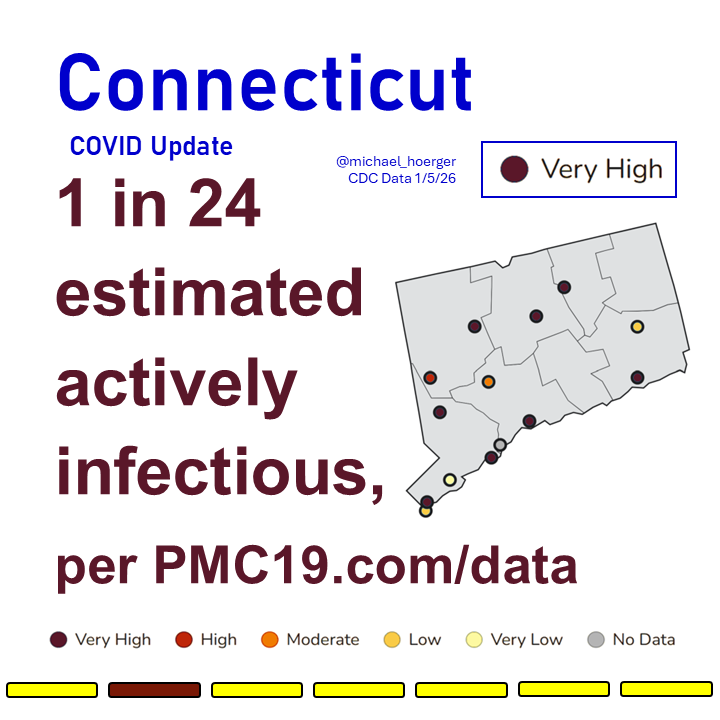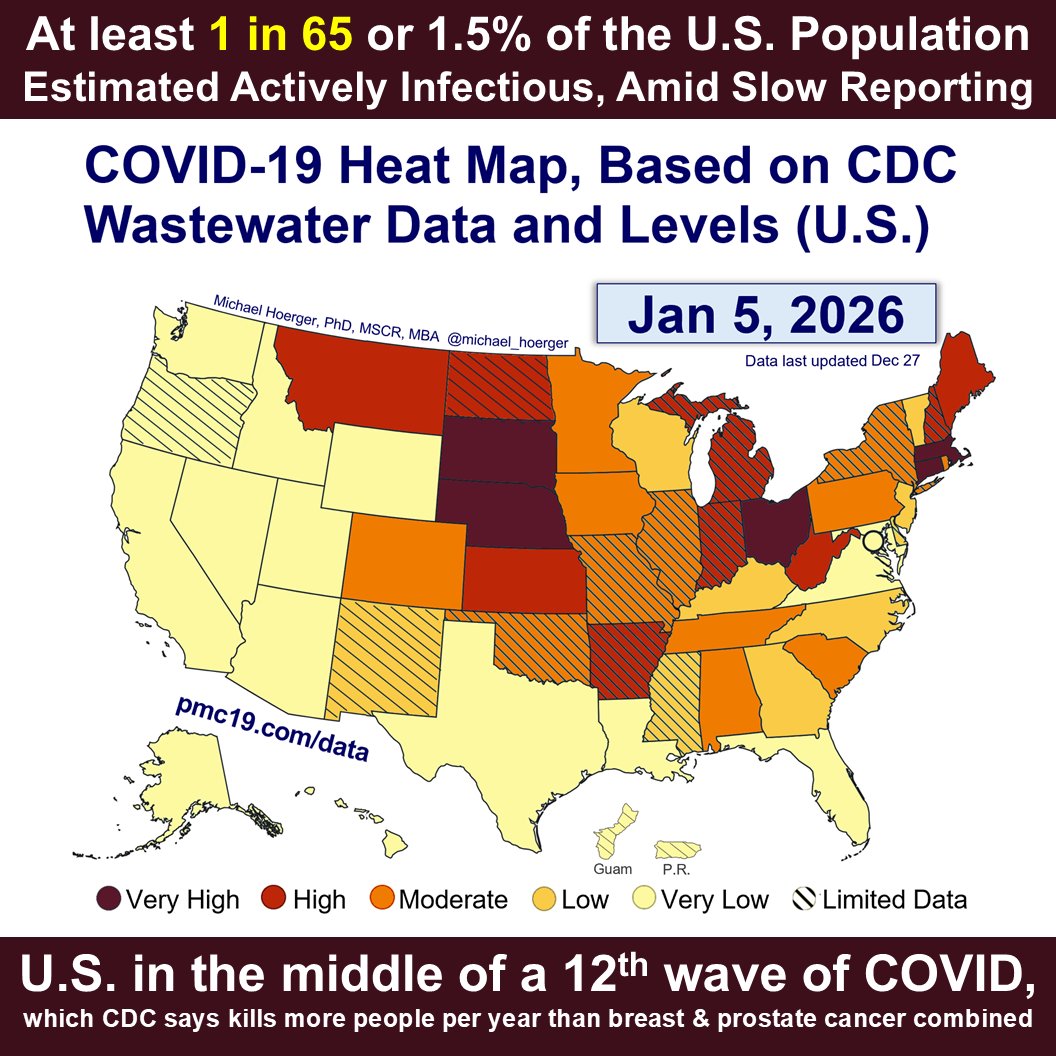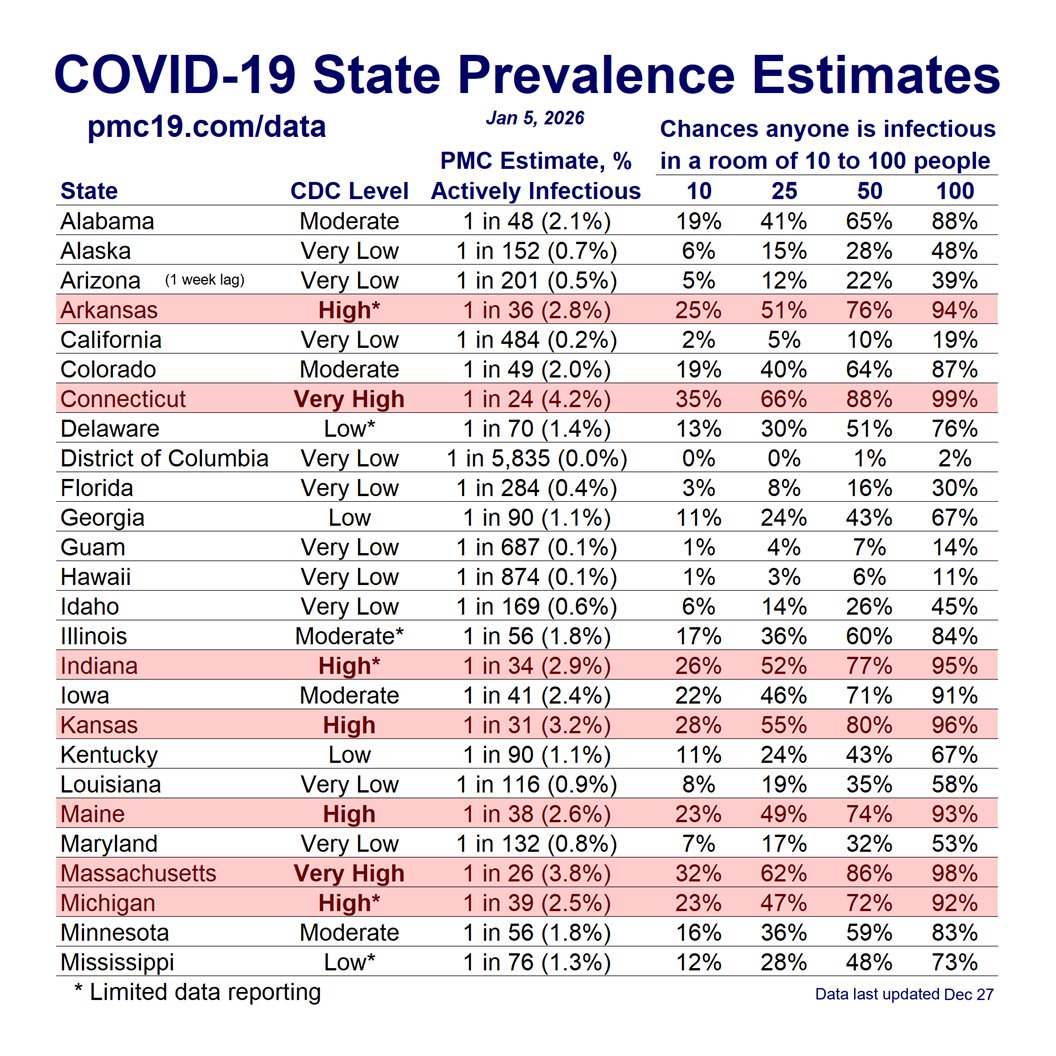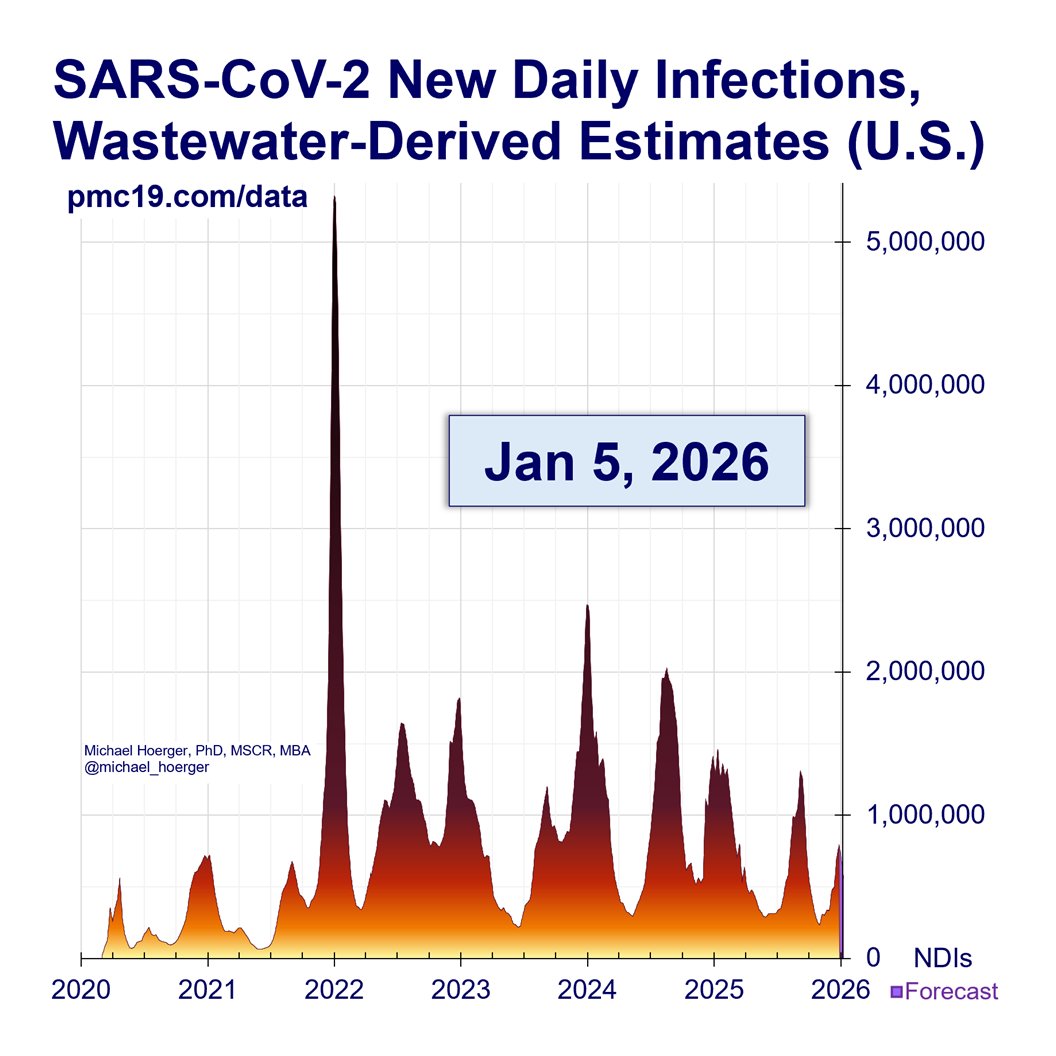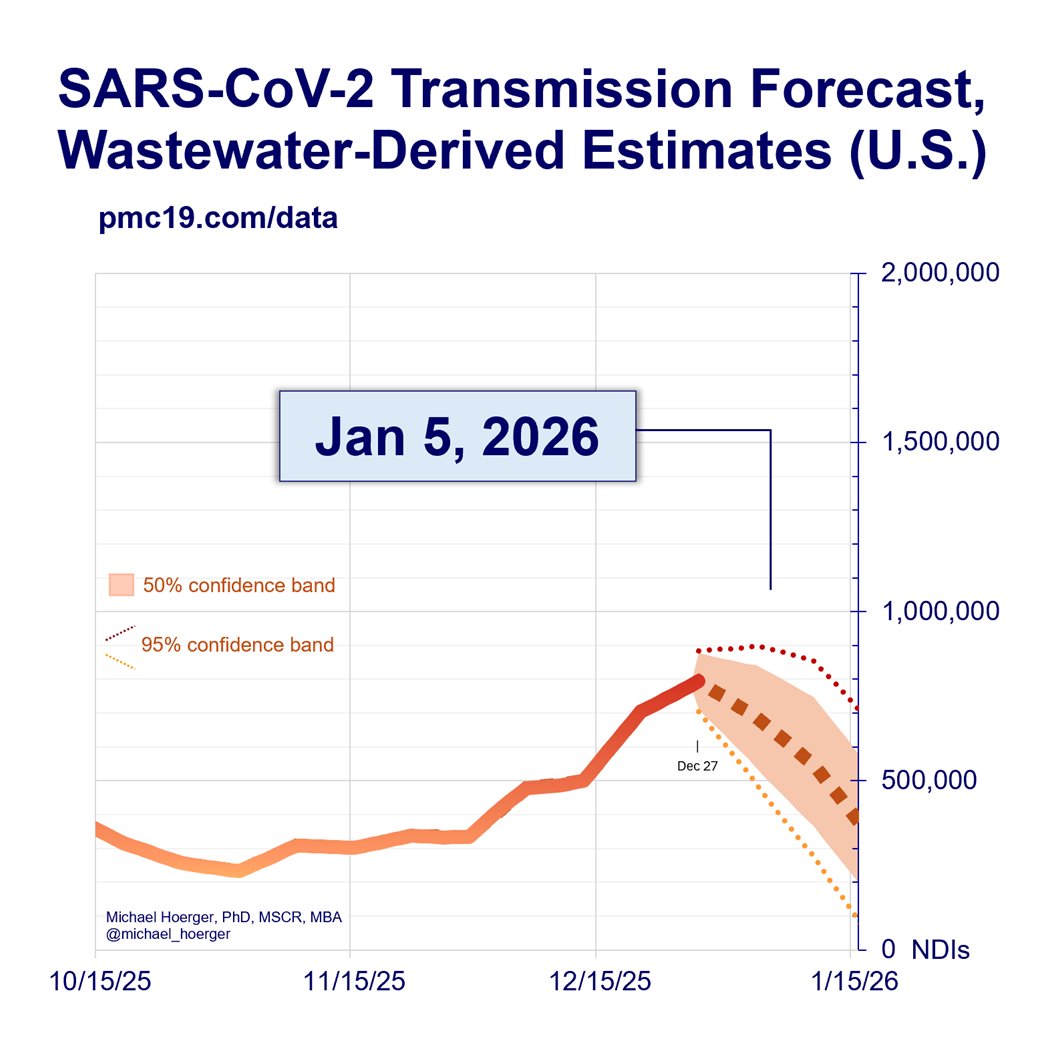PMC C0VID-19 Tracker, Nov 13, 2023
We're entering the 8th pandemic wave, likely surging to >2% infectious (>1 million cases/day) in a month.
Today's numbers:
🔹 1.41% (1 in 71) are infectious
🔹 >670,000 C0VID cases/day
🔹>34,000 #LongCovid cases/day
1/

We're entering the 8th pandemic wave, likely surging to >2% infectious (>1 million cases/day) in a month.
Today's numbers:
🔹 1.41% (1 in 71) are infectious
🔹 >670,000 C0VID cases/day
🔹>34,000 #LongCovid cases/day
1/

Note that the different forecasting models show high convergence.
December 11 by the Numbers:
🔹 2.25% (1 in 44) likely to be infectious
🔹 >1 million anticipated C0VID cases/day
🔹>50,000 resulting #LongCovid cases/day
2/
December 11 by the Numbers:
🔹 2.25% (1 in 44) likely to be infectious
🔹 >1 million anticipated C0VID cases/day
🔹>50,000 resulting #LongCovid cases/day
2/

Zooming out to the full #pandemic, there is no debate we're in an 8th U.S. C0VID wave, likely entering a "surge" in my view. That's not a word I take lightly.
There's more transmission than during 54% of pandemic days.
#MaskUp #VaxUp 😷💉
3/
There's more transmission than during 54% of pandemic days.
#MaskUp #VaxUp 😷💉
3/

How Does the Oncoming 8th Wave Compare with Prior Waves?
I suspect we’re headed somewhere between the magnitude of Wave 2 (winter 20-21) & Wave 6 (last winter). If so, I would characterize us as heading into a surge. I do not use the word “surge” lightly.
More...
4/
In comparing waves, I see a qualitative distinction at about 1 million daily infections (wastewater levels of 750 copies/mL).
Waves 1, 2, 3, and 7 all hovered around that mark. I refer to these as waves, not surges.
Wave 4, 5, and 6 all had sustained time periods of weeks with over 1 million infections per day. The “area under the curve” is substantially higher, and I refer to these as “surges.”
If one ventures to use this distinction, will Wave 8 be a wave like Waves 1, 2, 3, and 7, or more of a surge with sustained daily infections of >1 million per day?
Remember, the model uses a combination of historical data plus what is happening during the preceding 4 weeks. This means we will know best when a couple weeks out. Beyond 4 weeks, the model is relying heavily on historical data, and the three prior winters (Waves 2, 4, and 6) are very different. Wave 4 is an outlier among the waves, obviously. Wave 2 was more typical of a non-winter wave. Wave 6 (surge) piggybacked on Wave 5 (surge) and may have been unique in that regard due to any fleeting population-level immunity. My model suggests we’re headed toward a surge slightly bigger than last year, and I could see that, because any fleeting immunity from Wave 7 is likely less than that derived from Wave 5, and people are not up-to-date on vaccinations. Other behavioral precautions are similar for this versus last winter: mostly non-existent. However, the model does not capture any of that. It’s predicting worse (more infections) than last year because it’s influenced by the BA.1 wave.
Acknowledging that, I suspect we will peak slightly lower than Wave 6, perhaps around the 1.5 million infections/day rate. Anything between Wave 2 and a 20% bigger version of Wave 6, I would consider a reasonable estimate at this point.

I suspect we’re headed somewhere between the magnitude of Wave 2 (winter 20-21) & Wave 6 (last winter). If so, I would characterize us as heading into a surge. I do not use the word “surge” lightly.
More...
4/
In comparing waves, I see a qualitative distinction at about 1 million daily infections (wastewater levels of 750 copies/mL).
Waves 1, 2, 3, and 7 all hovered around that mark. I refer to these as waves, not surges.
Wave 4, 5, and 6 all had sustained time periods of weeks with over 1 million infections per day. The “area under the curve” is substantially higher, and I refer to these as “surges.”
If one ventures to use this distinction, will Wave 8 be a wave like Waves 1, 2, 3, and 7, or more of a surge with sustained daily infections of >1 million per day?
Remember, the model uses a combination of historical data plus what is happening during the preceding 4 weeks. This means we will know best when a couple weeks out. Beyond 4 weeks, the model is relying heavily on historical data, and the three prior winters (Waves 2, 4, and 6) are very different. Wave 4 is an outlier among the waves, obviously. Wave 2 was more typical of a non-winter wave. Wave 6 (surge) piggybacked on Wave 5 (surge) and may have been unique in that regard due to any fleeting population-level immunity. My model suggests we’re headed toward a surge slightly bigger than last year, and I could see that, because any fleeting immunity from Wave 7 is likely less than that derived from Wave 5, and people are not up-to-date on vaccinations. Other behavioral precautions are similar for this versus last winter: mostly non-existent. However, the model does not capture any of that. It’s predicting worse (more infections) than last year because it’s influenced by the BA.1 wave.
Acknowledging that, I suspect we will peak slightly lower than Wave 6, perhaps around the 1.5 million infections/day rate. Anything between Wave 2 and a 20% bigger version of Wave 6, I would consider a reasonable estimate at this point.

Although only at the start of the 8th wave, transmission is already high on Nov 13.
Large groups amplify transmission. For example, in a group of 20, there's about a 25% chance someone would have infectious C19. In a large lecture hall, it's assumed.
5/
Large groups amplify transmission. For example, in a group of 20, there's about a 25% chance someone would have infectious C19. In a large lecture hall, it's assumed.
5/

Here's an update on the danger of a #Thanksgiving gathering in the U.S. (Nov 23).
In a large gathering of 15-20 people, there's about a 25% chance someone would be infectious. I remain quite confident in these numbers, virtually identical to last week's forecast.
6/
In a large gathering of 15-20 people, there's about a 25% chance someone would be infectious. I remain quite confident in these numbers, virtually identical to last week's forecast.
6/

Here's an updated estimate on the possible danger of a #Christmas gathering in the U.S. (Dec 25).
I am exceedingly cautious on posting long-range forecasts.
7/
More...
They are speculative and do not account for the highly-valuable near-term fluctuations that can occur, particularly if there's an immune-evasive variant.
Take these as my best point estimates nearly two months out, for illustrative purposes just so people get an idea of how bad things may be. Many people are booking trips now, so these rough estimates may be useful. These estimates are virtually identical to those in the forecast from last week.
In a small gathering of 9-10 people, there's about a 25% chance someone is infectious. Once you start looking at large family or multi-family gatherings that span 20-25 people, you basically begin to assume someone has infectious C19.

I am exceedingly cautious on posting long-range forecasts.
7/
More...
They are speculative and do not account for the highly-valuable near-term fluctuations that can occur, particularly if there's an immune-evasive variant.
Take these as my best point estimates nearly two months out, for illustrative purposes just so people get an idea of how bad things may be. Many people are booking trips now, so these rough estimates may be useful. These estimates are virtually identical to those in the forecast from last week.
In a small gathering of 9-10 people, there's about a 25% chance someone is infectious. Once you start looking at large family or multi-family gatherings that span 20-25 people, you basically begin to assume someone has infectious C19.

Here's the full PMC Dashboard for Nov 13.
You can read the full report at
Please share across other social media platforms. Much appreciated. 🙏
8/ pmc19.com/data

You can read the full report at
Please share across other social media platforms. Much appreciated. 🙏
8/ pmc19.com/data

• • •
Missing some Tweet in this thread? You can try to
force a refresh



